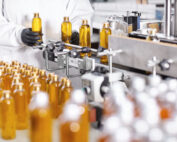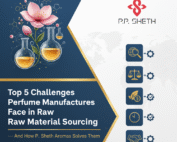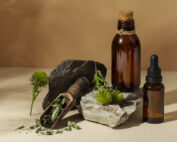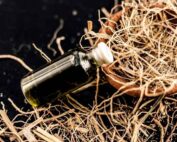Essential oils are often thought of as pure, natural, and chemical-free. But is that the case?
The truth is that essential oils do contain chemicals, but they’re naturally derived from plants and are responsible for the oils’ fragrance and therapeutic effects. In this blog, we’ll explain what these chemicals are, how they work, and why understanding them is key to using essential oils safely and effectively.
What Are Essential Oils?
Essential oils are concentrated plant extracts obtained through steam distillation, cold pressing, or solvent extraction. They carry the “essence” of the plant — its aroma and active compounds.
Once extracted, these essential oils are often blended with carrier oils to make them safe for topical or aromatic use.
Key Characteristics:
-
Extracted from flowers, leaves, bark, or roots
-
Highly aromatic
-
Contain bioactive compounds that affect the body and mind

Do Essential Oils Contain Chemicals?
Yes — essential oils are made up of hundreds of natural chemical compounds. These include terpenes, esters, aldehydes, and phenols, which give each oil its unique aroma and properties.
For example:
-
Lavender Oil contains linalool and linalyl acetate
-
Peppermint Oil contains menthol and menthone
-
Chamomile has sesquiterpenes and flavonoids
These chemical components occur naturally in plants and are not synthetic unless the oil is adulterated.
Also Read: Natural vs. Synthetic Aroma Chemicals: What’s the Difference?
How Essential Oils Are Used in the Aroma Chemical Industry
1. Perfumery:
The aroma of commercial perfumes can be overwhelming, and they may include hazardous compounds that you are inhaling in. Essential oils are made from plant parts. These essential oils have a captivating aroma and have a significant impact on the globe. They can be found in a wide range of everyday products. Essential oil is utilized in perfumery because it smells good and also improves your mood and mental health.
2. Cosmetics & Skincare:
Essential oils have regained popularity in recent years. They are commonly utilized in the cosmetics industry as fragrances and active ingredients. Furthermore, their capacity to impart a wide range of distinct and pleasant smells in cosmetic goods while also serving as bioactive agents (anti-aging, antibacterial, UV protection, and whitening) makes them highly coveted and valuable ingredients in cosmetics and cosmeceutical products.
3. Aromatherapy:
A natural method of curing the mind, body, and soul is aromatherapy. Aromatherapy uses essential oils to penetrate the surface of the human skin with a noticeable aura, and the main techniques are inhalation, topical application, and baths. Once the oils are in the system, they self-modulate and perform amicably in the affected area.
This kind of treatment uses different combinations and permutations to treat a wide range of conditions, including depression, indigestion, headaches, sleeplessness, muscle pain, respiratory issues, skin conditions, swollen joints, and disorders related to the urine.
4. Pharmaceuticals:
Essential oils from aromatic and therapeutic plants are utilized in pharmaceuticals to treat a variety of ailments. They have been employed since ancient times due to their biological, antibacterial, and antifungal characteristics. Lavender oil is used to heal wounds and has antibacterial, antioxidant, and anti-inflammatory effects. Eucalyptus oil is used to treat coughs, colds, and moderate muscular pain.
Also Read: Rosemary Essential Oil for Face: Benefits, How to Use, and Precautions
Are the Chemicals in Essential Oils Safe?
Due to their high concentration, essential oils can irritate the respiratory system when inhaled directly. This could result in symptoms including shortness of breath, inflammation of the nose and throat, or coughing. Asthma and chronic obstructive pulmonary disease (COPD) are two respiratory disorders that may make people more vulnerable to these symptoms.
Essential oils can also trigger allergic responses when applied topically or breathed. Before using any particular oil, it is crucial to know if you have any allergies or sensitivities.
Factors Influencing Essential Oil Safety:
1. Purity & Quality:
The quality and source of the plants used to make essential oils have a significant impact on their purity. The production of pure essential oils requires organic farming without the use of artificial fertilizers or pesticides. Plants cultivated in polluted conditions or exposed to toxic chemicals may have pollutants that can make their way into the finished product.
2. Dilution:
In the essential oil sector, adulteration is a major worry. In order to boost revenues, some dishonest producers may dilute pure oils with artificial additives or inferior oils. This jeopardizes the oil’s medicinal properties and purity. To guarantee authenticity, look for vendors who offer batch-specific GC/MS data or third-party testing.
3. Extraction Method:
Essential oils are extracted from plant material using a variety of techniques, including solvent extraction, steam distillation, and cold pressing. Every technique has an impact on the oil’s potency and purity. The most popular and recommended technique for creating premium oils is steam distillation. However, solvent extraction could compromise purity by leaving behind residues of the chemicals utilized in the procedure.
4. Storage:
Another important factor in preserving the purity of essential oils is how they are stored. Due to their sensitivity to heat, light, and air, essential oils may degrade and lose their effectiveness. Oils should always be kept in cool, dry locations in dark glass bottles out of direct sunlight.

Natural vs. Synthetic Chemicals in Essential Oils
Pure essential oil use is often referred to as “aromatherapy.” Pure, high-quality essential oils are made from plants, produced without the use of pesticides, and meticulously distilled to provide “therapeutic” or health advantages.
Many of these essential oils have beautiful scents that are not only pleasing to the senses but also good for your health.Conversely, synthetic essential oils are created in a lab using chemicals to mimic the scents they are meant to mimic.
It is important to distinguish these oils from pure, natural essential oils because they are not “therapeutic” oils. Since the skin is the largest organ in the body, synthetic scents should never be applied to it because some of the chemicals used to make them are hazardous.
Know More:Differences Between Essential Oils and Normal Oils
The Role of Chemicals in the Benefits of Essential Oils
Essential oils are most widely utilized in aromatherapy, which involves inhaling them using a variety of methods. Essential oils are not intended to be swallowed. The chemicals in essential oils can interact with your body in a variety of ways. When applied to the skin, some plant chemicals are absorbed.
Certain application methods, such as heating or applying to different parts of the body, are thought to increase absorption. Inhaling the fragrances of essential oils can trigger sections of your limbic system, which is a component of your brain that controls emotions, behaviors, smell, and long-term memory. The limbic system is responsible for memory formation and controlling physiological functions like breathing, heart rate, and blood pressure. Some believe that essential oils can have a physical effect on the body.
Conclusion: Do Essential Oils Have Chemicals?
Aromatic chemicals, which give essential oils their unique fragrances and medicinal qualities, are at the heart of these oils. The most prevalent aromatic chemicals are terpenes, aldehydes, and esters.
Essential oils contain terpenes, which have anti-inflammatory and antibacterial qualities. For example, limonene, a terpene present in citrus oils, has been demonstrated to lower stress and improve mood. Aldehydes, such as citral in lemongrass oil, have powerful antibacterial and antifungal properties. Esters, another group of aromatic compounds, are frequently commended for their ability to induce relaxation. Lavender oil’s linalyl acetate is a prime example of an ester that aids in promoting relaxation and lowering anxiety.
You can select the best essential oils for your requirements by being aware of these chemicals. Knowing the chemical composition of these oils can help your aromatherapy practice be more successful, whether your goal is to reduce stress, increase immunity, or just enjoy a nice scent.
If you’re looking for a trusted source of pure and high-quality essential oils, PP Sheth stands out as a leading essential oil supplier in India, offering products with uncompromised quality and efficacy.
Also Read this blog: Lavender Oil
Most Recent Posts









